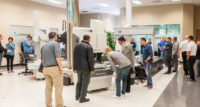NORTH CHARLESTON, S.C.—The Coordinate Metrology Society (CMS) announced today William (Bill) Gressler from the LSST Project will serve as the keynote speaker at the 30th Annual Coordinate Metrology Systems Conference (CMSC), July 21-25, at the Embassy Suites North Charleston – Airport/Hotel & Convention, in North Charleston, S.C.
Mr. Gressler is the Telescope and Site Manager for the LSST (Large Synoptic Survey Telescope) Project, based in Tucson, Ariz. He will discuss the advancements in metrology that have enabled the 3-mirror LSST telescope and its 3-element refractive camera designs to provide a 3.5-degree field of view integrated optical system.
His keynote address, entitled “Metrology Systems Enable Big Science,” will cover how telescopes were among the first key metrology systems to help scientists to understand the universe and provide a glimpse of the future of our planet.
Gressler’s keynote address is scheduled to officially kick-off CMSC’s technical sessions at 9 a.m. on Tuesday morning, July 22. The CMSC is celebrating 30 years as the world-leading forum for 3D Measurement /Inspection professionals and scientists. The annual 5-day conference provides an unrivaled schedule of original, expert technical presentations in the field of metrology.
The LSST Project will begin construction of an 8-meter ground based observatory in Chile in late 2014, which will field the largest digital camera ever constructed (3.2-Gpixel). This telescope has and will continue to rely on high precision metrology technologies for production and alignment. During its 10-year mission, the LSST will scan the entire visible sky and collect an unprecedented database of astronomical images, catalogues, and data products. It will open a movie-like window to view rapidly moving or changing objects, exploding supernova, distant Kuiper Belt Objects, and potentially dangerous near-Earth asteroids.
The LSST Project intends to use metrology systems to provide precision alignment of the telescope as it monitors the sky from high on a mountaintop throughout the night. The astronomical data captured is expected to provide insight into the mysteries of dark matter and dark energy, and provide a detailed mapping of the Milky Way. This information will be made available to the public to support education and science literacy.
For more information, visit www.CMSC.org.


